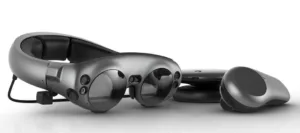iFixit has made a detailed teardown of the long-awaited Magic Leap development system.
The teardown describes the way that the Magic Leap headset uses six different optical waveguides, each with a small air gap and with the edges painted black. The waveguides are organised as two groups of three, one each for RG&B and with each group having a different focal plane, to help with realism. (The waveguides have to be in threes because they each work at specific colour frequencies).
The display devices is an OmniVision OPO2222 field-sequential LCOS display that the site believes is likely to be a customised version of the OmniVision OP02220. (Kudos to occasional Display Daily contributor, Karl Guttag, for suggesting this back in November 2016 – Guttag contributed to the teardown). The LCOS is illuminated by a ring of six LEDs in red, green and blue.
The headset includes gaze tracking.
The site looks at the system unit, which is designed to be clipped to a pocket (on the outside) and is based around an Nvidia Tegra X2 processor with a Pascal GPU and 8GB of RAM as well as 128GB of flash memory.
iFixit has given the Magic Leap One augmented reality headset a repairability score of 3 out of 10. The report says, “With this much glue on this many fragile components, you’d better have buckets of patience and a very steady hand. The battery is only replaceable if you’re willing to remove the motherboard and tiptoe your way past several intense glue barriers”.
However, the device’s speakers are apparently easy to remove and replace with a screwdriver and the threaded fasteners are all of the standard Torx and Phillips variety.
You can check out the teardown report in its entirety here.
Analyst Comment
The Magic Leap has been described by Palmer Luckey (who helped with the tear down) as “less of a functional developer kit and more of a flashy hype vehicle that nobody can actually use in a meaningful way” and Luckey said that it does not deliver on its promise. He describes the tracking as ‘bad’ compared to other systems on the market (halfway between PSVR and Rift, he said) and he also dislikes the controller. On the other hand, he likes the idea of moving the electronics to the belt/pocket pack – a move I also thinks makes sense as it significantly reduces the weight on the head. Luckey suggests that the two waveguide groups have focal planes at around 0.75 metres and about 5 metres. He sees this as a big weakness, although at SID, Oculus said that you might be able to get away with just two planes if you track gaze. (KN02 Oculus Looks for Windows on the Real World) (BR)

